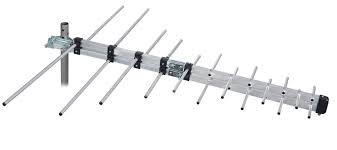A Yagi antenna, often referred to as a Yagi-Uda antenna, is a highly efficient directional antenna widely used in radio frequency (RF) communication. Its unique design, excellent performance, and versatility make it a preferred choice in various applications, ranging from broadcasting to wireless communication. This article delves into the structure, functionality, applications, and advantages of Yagi antennas, with a focus on how they meet the needs of modern communication systems.
What is a Yagi Antenna?
The Yagi antenna is a type of directional antenna consisting of a driven element, reflector, and one or more directors. It was invented in the 1920s by Japanese engineers Hidetsugu Yagi and Shintaro Uda, giving it the name Yagi-Uda antenna. The primary purpose of this antenna is to focus RF energy in a specific direction, enhancing signal strength and reducing interference from other directions.
The antenna’s design typically includes:
- Driven Element: This is the active part of the antenna, connected to the transmitter or receiver. It acts as the source of radiation or reception.
- Reflector: Positioned behind the driven element, the reflector directs RF energy toward the front of the antenna by reflecting signals that would otherwise propagate backward.
- Directors: These are additional elements placed in front of the driven element. They focus the energy into a narrow beam, enhancing the antenna’s gain and directivity.
Key Characteristics of Yagi Antennas
Directionality
The directional Yagi antenna is designed to focus RF energy in a specific direction. This characteristic is critical in applications where a targeted signal is required, as it minimizes interference from unwanted sources.
High Gain
Yagi antennas provide high gain, which refers to their ability to amplify signals in the desired direction. This feature makes them ideal for applications requiring long-distance communication or enhanced signal quality.
Compact Design
Despite their powerful performance, Yagi antennas are relatively compact and lightweight. Their design allows for easy installation and integration into various systems without requiring significant space.
Frequency Range
Yagi antennas can be designed to operate within specific frequency ranges, making them adaptable to various applications, including television broadcasting, amateur radio, and wireless networking.
Applications of Yagi Antennas
Television Broadcasting
In television broadcasting, Yagi antennas are used to receive signals from transmission towers. Their high gain and directionality enable viewers to receive clear signals even in areas with weak reception. By pointing the antenna toward the nearest broadcast tower, users can optimize signal quality and reduce interference.
Amateur Radio
Amateur radio operators often use Yagi antennas to communicate over long distances. The antenna’s ability to focus energy in a specific direction allows operators to establish reliable connections, even in challenging conditions. Its compact design also makes it suitable for use in portable setups.
Wireless Networking
Yagi antennas are increasingly used in wireless networking to extend the range of Wi-Fi signals. By directing the antenna toward a specific location, users can improve connectivity and reduce signal loss. This application is particularly useful in rural areas or large properties where standard Wi-Fi signals may not reach.
Cellular Networks
In cellular networks, Yagi antennas enhance signal strength and coverage for both base stations and end users. Their directional nature helps in improving communication reliability, especially in areas with weak signals.
Research and Monitoring
Yagi antennas are used in scientific research and environmental monitoring to track signals from remote sensors. Their precision and reliability make them invaluable in applications such as wildlife tracking and weather monitoring.
Advantages of Yagi-Uda Antennas
Improved Signal Quality
The Yagi-Uda antenna focuses RF energy in a specific direction, enhancing signal strength and reducing interference. This ensures reliable communication even in areas with high noise levels.
Cost-Effectiveness
Yagi antennas are relatively inexpensive to manufacture and install, making them a cost-effective solution for a wide range of applications. Their durability and low maintenance requirements further add to their affordability.
Easy Installation
The compact and lightweight design of Yagi antennas simplifies installation. They can be mounted on poles, towers, or walls with minimal effort, making them accessible to both professional and amateur users.
Versatility
Yagi antennas can be customized to operate within specific frequency ranges and for various purposes. This adaptability makes them suitable for diverse applications, from broadcasting to industrial communication.
Choosing the Right Yagi Antenna
When selecting a directional Yagi antenna, consider the following factors:
Frequency Range
Ensure that the antenna is designed to operate within the desired frequency range. Using an antenna optimized for the wrong frequency can result in poor performance.
Gain and Beamwidth
Higher gain provides better signal amplification, while beamwidth determines the coverage area. Choose a Yagi antenna with the appropriate balance of gain and beamwidth for your application.
Material and Build Quality
Select an antenna made from high-quality materials to ensure durability and long-term performance. This is particularly important for outdoor installations exposed to harsh weather conditions.
Mounting Options
Consider the mounting options provided by the antenna. Ensure that it can be easily installed in your desired location and oriented toward the target signal source.
Installation and Maintenance Tips
Proper Alignment
For optimal performance, align the Yagi antenna precisely with the signal source. Use tools such as signal meters to ensure accurate positioning.
Regular Inspections
Conduct regular inspections to check for signs of wear, damage, or misalignment. Early detection of issues allows for timely maintenance and prevents performance degradation.
Weather Protection
If installed outdoors, protect the antenna from extreme weather conditions. Consider using weather-resistant materials or coatings to extend its lifespan.
Conclusion
The Yagi antenna is a versatile and powerful tool in RF communication, offering high gain, directionality, and reliability. Its applications range from television broadcasting and amateur radio to wireless networking and scientific research. The Yagi-Uda antenna continues to be a preferred choice for professionals and enthusiasts seeking efficient and cost-effective signal transmission. By selecting the right antenna and ensuring proper installation and maintenance, you can maximize the performance and longevity of this indispensable RF component.
